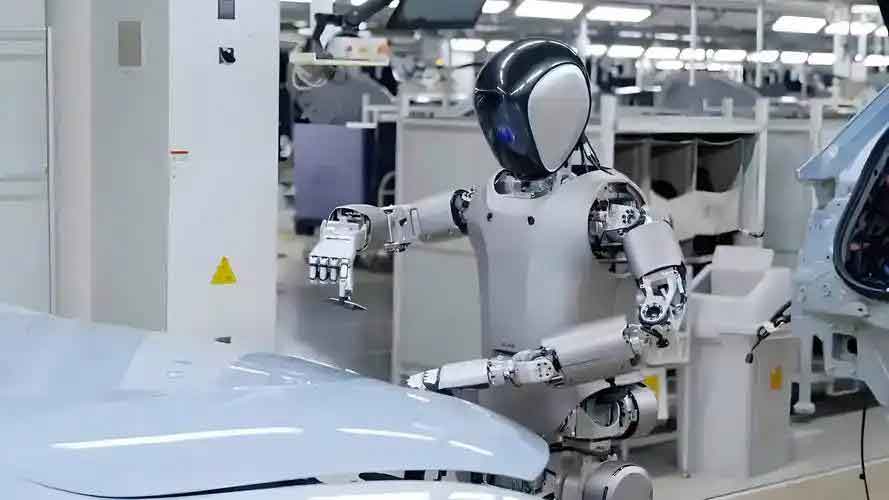
The spotlight at the Chinese New Year Gala was stolen by 16 humanoid robots dressed in floral-patterned cotton jackets, effortlessly twirling handkerchiefs. These humanoid robots, named Fu Xi and developed by Unitree, quickly became a sensation, with market demand far exceeding supply. According to the company, humanoid robot production will reach new scales by year-end, with industrial and service sector applications planned for 2025. This phenomenon raises critical questions: Are we approaching the era of humanoid robots? How soon will these humanoid robots integrate into daily life?
1. Historical Evolution of Robotic Technology
Robotic technology traces back over 2,000 years. Ancient Greeks created steam-powered singing devices in the 2nd century BC, while during China’s Eastern Han Dynasty, Zhang Heng invented the “Li-Drum Cart” – a mileage-measuring robot featuring wooden figures that struck drums and bells at fixed distances. The modern era began in the 1950s when American inventors George Devol and Joseph Engelberger created Unimate 001, the first digitally controlled industrial robot. A significant leap occurred in 1973 when Japan’s Waseda University team led by Ichiro Kato developed WABOT-1, the first full-scale humanoid robot with limbs, vision, tactile sensors, and conversation capabilities.
Robotic evolution divides into three generations:
- First-generation Programmable Robots (1960s-present): Execute repetitive tasks via coded instructions, widely deployed in manufacturing.
- Second-generation Sensory Robots: Equipped with environmental perception for adaptive responses, used selectively in industrial settings.
- Third-generation Intelligent Robots: Incorporate recognition, reasoning, and learning capabilities. While not exclusively humanoid, systems like autonomous vehicles represent this experimental phase.
2. The Drive Toward Humanoid Form
Most current robots are non-humanoid industrial units deployed in manufacturing, construction, mining, and hazardous environments. However, humanoid robots uniquely merge functional utility with psychological resonance. China’s Ministry of Industry and Information Technology emphasizes that humanoid robots integrate AI, advanced manufacturing, and materials science, positioning them as potential disruptive products following computers and smartphones.
Critical to this evolution is Embodied Artificial Intelligence (EAI), enabling humanoid robots to perceive, learn, and dynamically interact. EAI requires convergence of multiple technologies:
- Computer vision (pattern recognition, image processing)
- Natural language processing (speech recognition, dialogue systems)
- Cognitive reasoning (physical/social常识)
- Robotics (kinematics, control systems, motion planning)
- Machine learning (statistical modeling, computational methods)
The preference for humanoid robots stems from deep-rooted psychological affinity. Trust emerges through familiarity with human-like appearance, behavior, and interaction patterns. Biological evolution further validates the humanoid form as optimal for navigating complex terrestrial environments – walking, climbing, and manipulating objects. Future humanoid robots will likely incorporate ethnic-specific anthropometric data to enhance social acceptance.
3. China’s Advancements in Humanoid Robotics
Global humanoid robot development is led by companies in the US, China, Japan, and the UK. China’s rapid progress is marked by several breakthroughs:
- CETC Robot-1 (CETC 21st Institute): 1.62m, 60kg humanoid robot with 39 degrees of freedom. Capable of carrying 10kg loads and traversing uneven terrain at 5km/h.
- Unitree H1 (Fu Xi): 1.8m, 47kg humanoid robot achieving 3.3m/s movement speeds. Features 360° perception, 360N·m joint torque, and synchronized group performances using 3D SLAM navigation.
- Unitree G1: Compact 1.27m, 35kg model with 120N·m torque. Performs dynamic movements like sprinting and backflips, equipped with force-sensitive dexterous hands for precision tasks like welding and handling fragile objects.
At recent global AI conferences, Chinese humanoid robots like Unitree’s H1 and Xiaopeng’s PX5 (capable of soccer and obstacle navigation) demonstrated world-leading capabilities, confirming China’s competitive position in humanoid robotics.
4. Global Leaders and Market Projections
International advancements highlight accelerating innovation:
- Boston Dynamics’ Atlas (2014): Hydraulic-powered, 1.8m humanoid robot performing parkour, backflips, and complex gymnastics with LiDAR and stereo vision.
- Tesla’s Optimus (2022): Designed for factory logistics and future home assistance (cooking, eldercare).
Industry forecasts indicate humanoid robot adoption will unfold in phases:
| Application Phase | Timeframe | Key Metrics |
|---|---|---|
| Industrial Deployment | 2024-2027 | Initial specialized applications |
| Consumer Market Entry | 2028-2031 | Price reduction critical |
| Mass Production | By 2035 | 1.4 million units ($38B market) |
5. Challenges Before Widespread Adoption
Despite progress, significant barriers remain:
- Technical Refinement: Current humanoid robots lack fluid human-like mobility. For example, Fu Xi required human assistance to exit the New Year Gala stage despite its 3.3m/s speed capability. Improvements in real-time environmental response and untrained voice-command recognition are essential.
- Cost Reduction: Production costs exceeding $100,000 must decrease to below $10,000 for consumer accessibility. Limited precision component supply chains constrain manufacturing scale.
- Safety and Ethics: Incidents like rumored Tesla Optimus accidents underscore safety concerns. Ethical dilemmas regarding military deployment persist, especially as non-humanoid robots already see combat use.
Humanoid robots represent the pinnacle of AI integration – a transformative technology gradually overcoming technical, economic, and ethical challenges. As development accelerates globally, these machines move steadily toward becoming indispensable assistants in workplaces and homes worldwide.